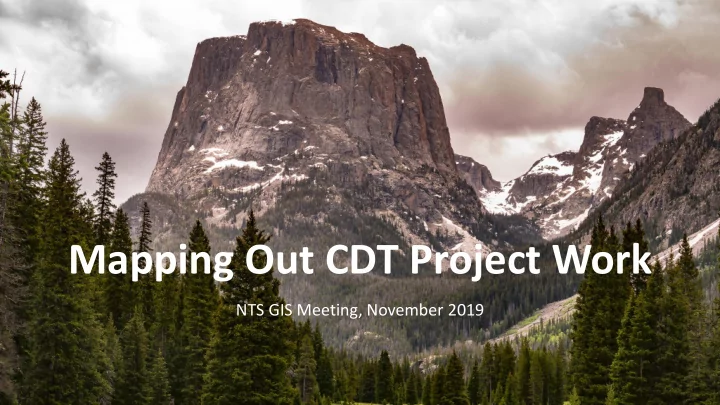

Mapping Out CDT Project Work NTS GIS Meeting, November 2019
Introduction • Taylor Willow (she/her/hers) • MSc in GIS, University of Edinburgh (2018) • CDT Resource Assistant – Southwest Conservation Corps (Oct. 2018 – Aug. 2019), • Supervised by Brenda Yankoviak, Continental Divide Trail Administrator (USFS Region 2 Office – Denver) • CDT & Geospatial Resource Assistant - MobilizeGreen (Sept. 2019 – present) • 50% time with Resource Information in Region 2 – supervised by Victoria Smith-Campbell, GIS Coordinator • taylor.willow@usda.gov
Overview Share a new spatially-enabled system for tracking project proposals along the Continental Divide Trail, and demonstrate how it is supporting funding and management decisions • Context: how CDT is funded, original project proposal process, need for new system • Development process: constraints and considerations • End result: overview and demo • Takeaway points: results and benefits • Discussion/Questions
CDT Funding • USDA Forest Service is administering agency • CDT program receives a $1.67M WO earmark • Trail Administrator manages that budget allocation • Bulk of the funding is distributed to the 20 CDT forests across Regions 1-4 based on a competitive project proposal process • Interagency, multi-regional team evaluates and identifies priority projects for funding • Occasionally funding is spent on NPS and BLM projects when units unable to secure funding through their own budget allocations • Fund a few partnerships off the top (CDTC, CTF, MWA, etc.) • Trail Administrator salary, GIS support, travel, and training
Original Workflow • Early spring timeframe to submit projects for next fiscal year • FS Recreation staff at the Forest or District level submit project proposal details such as: • Amount of funding requested • Volunteer and partnership opportunities • Detailed description of proposed activity • Based entirely within SharePoint Lists; tabular data only • Optional spatial data submission as an attachment; used rarely, many submission errors (missing shapefile components, etc.), various data types • Trail Administrator and an interagency team meet to decide which projects will be funded and how much to allocate
The Challenge • The need: ability to visualize distribution of project proposals for better decision making and tracking through time. • Brenda’s vision: a web map displaying all submitted project proposals along with associated information. • Spatial, interactive, intuitive, informative • Working as much as possible within the existing project proposal workflow, develop a way to submit spatial data for project locations alongside tabular data, and display the submissions in a web map.
Constraints/Considerations • Keep the process simple and easy for non-technical users (Recreation staff) while minimizing back-end QC/processing • Continuing to use SharePoint in workflow was highly encouraged • Maintain ability to set permission levels for record submission and editing, record user metadata (created by, modified by, dates) • USFS does not have enterprise login for ArcGIS Online • Type of geometry – lines or points • Lines reflect real-world geometry of trail sections • More barriers to submission of line data for non-technical users • Points are easier to visualize on small-scale map • What tools to use? • How to integrate multiple tools/steps into a single workflow?
The New System • SharePoint site hosts embedded Survey123 and AGOL widgets for one- stop project proposal submission • SharePoint list: entry of tabular data • SharePoint workflow automatically generates a unique Project ID for each project proposal • Survey123: entry of point location for project • User defines a point on the map and enters the Project ID – primary key • For long trail segments or forest-wide projects, an approximate midpoint or endpoint is accepted. • ArcGIS Online web app: data display and analysis • Back end – QC submissions (Project ID or location entry errors), join tabular and spatial data, add to AGOL web app, configure custom filters
Demonstration
Results and Benefits • Transition to new system has been smooth, with very little user confusion and high data entry success rate • See distribution of current year’s proposals • Track funding patterns over time (will become more robust after years of use) • Better accountability for funding decisions • Takeaway message: adding a spatial component to project proposals uniquely supports management decisions and reveals patterns through time
Questions & Discussion
Recommend
More recommend